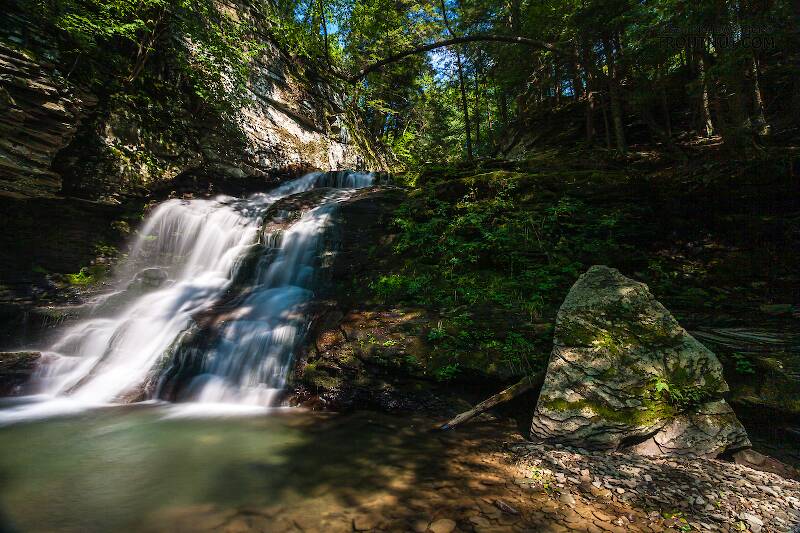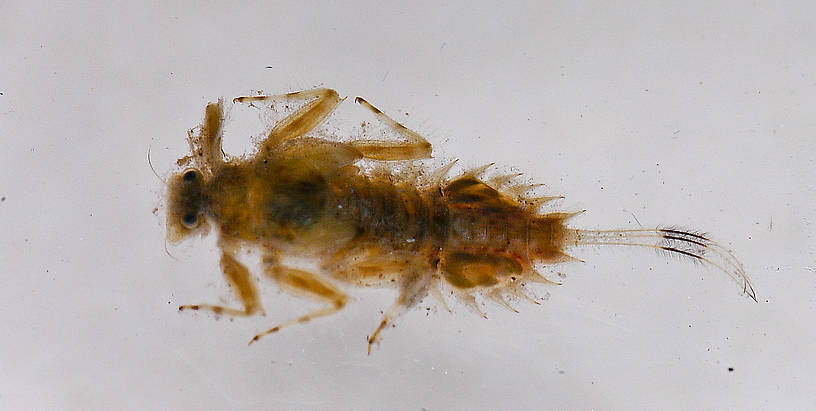
Hex Mayflies
Hexagenia limbata
The famous nocturnal Hex hatch of the Midwest (and a few other lucky locations) stirs to the surface mythically large brown trout that only touch streamers for the rest of the year.
Featured on the forum
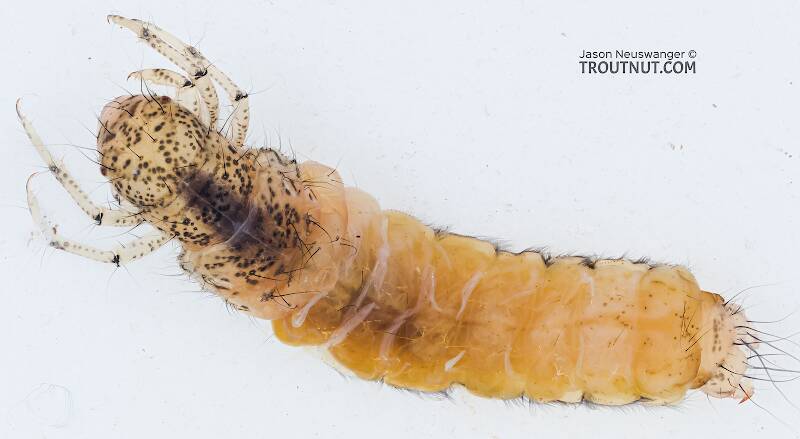
This is a striking caddis larva with an interesting color pattern on the head. Here are some characteristics I was able to see under the microscope, but could not easily expose for a picture:
- The prosternal horn is present.
- The mandible is clearly toothed, not formed into a uniform scraper blade.
- The seems to be only 2 major setae on the ventral edge of the hind femur.
- Chloride epithelia seem to be absent from the dorsal side of any abdominal segments.
Based on these characteristics and the ones more easily visible from the pictures, this seems to be Grammotaulius. The key's description of the case is spot-on: "Case cylindrical, made of longitudinally arranged sedge or similar leaves," as is the description of the markings on the head, "Dorsum of head light brownish yellow with numerous discrete, small, dark spots." The spot pattern on the head is a very good match to figure 19.312 of Merritt R.W., Cummins, K.W., and Berg, M.B. (2019). The species ID is based on Grammotaulius betteni being the only species of this genus known in Washington state.
- The prosternal horn is present.
- The mandible is clearly toothed, not formed into a uniform scraper blade.
- The seems to be only 2 major setae on the ventral edge of the hind femur.
- Chloride epithelia seem to be absent from the dorsal side of any abdominal segments.
Based on these characteristics and the ones more easily visible from the pictures, this seems to be Grammotaulius. The key's description of the case is spot-on: "Case cylindrical, made of longitudinally arranged sedge or similar leaves," as is the description of the markings on the head, "Dorsum of head light brownish yellow with numerous discrete, small, dark spots." The spot pattern on the head is a very good match to figure 19.312 of Merritt R.W., Cummins, K.W., and Berg, M.B. (2019). The species ID is based on Grammotaulius betteni being the only species of this genus known in Washington state.

Troutnut is a project started in 2003 by salmonid ecologist Jason "Troutnut" Neuswanger to help anglers and
fly tyers unabashedly embrace the entomological side of the sport. Learn more about Troutnut or
support the project for an enhanced experience here.
Great Brown Spinners
Like most common names,"Great Brown Spinner" can refer to more than one taxon. They're previewed below, along with 4 specimens. For more detail click through to the scientific names.
Mayfly Species Litobrancha recurvata
These are sometimes called Great Brown Spinners.
Litobrancha recurvata is generally reported to be the largest North American species of mayfly in angler entomologies, though this understanding is being challenged by reports of Hexagenia limbata that may exceed 40mm in some locales. Regardless, it is certainly the largest mayfly in the region of its distribution. Sometimes it appears together with species of Hexagenia or Ephemera, but in other places it creates excellent action on its own.
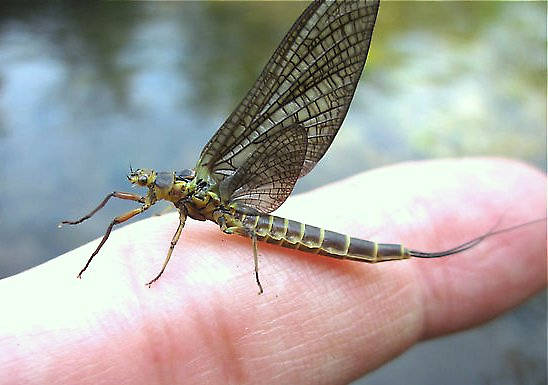
These photos were contributed by Spencer Vanderhoof.
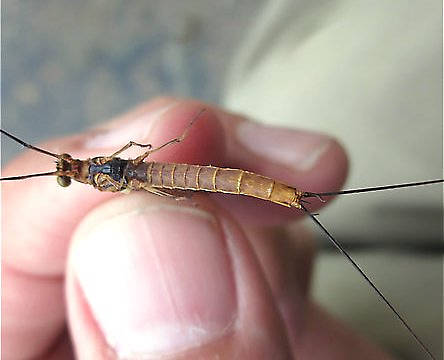
These photos were contributed by Spencer Vanderhoof.
See 1 more specimen...
Mayfly Species Timpanoga hecuba
These are very rarely called Great Brown Spinners.
Timpanoga hecuba is not abundant enough, and its emergence not concentrated enough to provide great hatches, but where it is locally abundant it creates fishable action because of its large size. This species seems subject to substantial fluctuations in population densities, possibly in relation to the amount of silted habitat they prefer. When silt builds up in drought years, their numbers appear to increase. It is the largest species in the Ephemerellidae family, often rivaling Drunella grandis (Western Green Drake) in length but appearing even stouter due to its dramatic lateral abdominal spines. It contains two subspecies. See the Timpanoga genus hatch page for details.
Anglers call them by a confusing array of names, although many fly shops have fortunately started to clear things up by rightly calling them Hecubas. Great Red Quill and Western Red Drake seem fairly descriptive, and some refer to them as Giant Dark Hendricksons. A fly shop serving Yellowstone out of Gardiner, Montana calls them Drake Mackerels in their hatch chart.
Anglers call them by a confusing array of names, although many fly shops have fortunately started to clear things up by rightly calling them Hecubas. Great Red Quill and Western Red Drake seem fairly descriptive, and some refer to them as Giant Dark Hendricksons. A fly shop serving Yellowstone out of Gardiner, Montana calls them Drake Mackerels in their hatch chart.
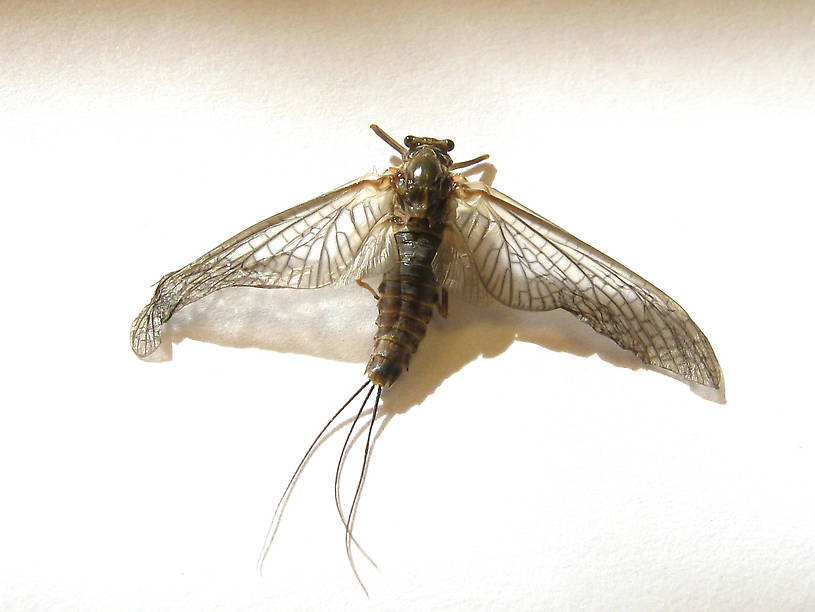
This specimen is 14 mm. Technically this is the subspecies T. h. hecuba. The Cascades, Sierras and further West is where the other subspecies, T. h. pacifica is found. The Great Basin seems to have formed a barrier preventing any overlap in their distribution.
See 1 more specimen...
References
- Merritt R.W., Cummins, K.W., and Berg, M.B. 2019. An Introduction to the Aquatic Insects of North America (Fifth Edition). Kendall/Hunt Publishing Company.

